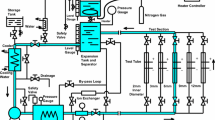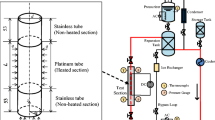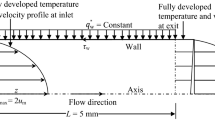Abstract
The turbulent heat transfer, the subcooled boiling heat transfer and the steady state CHF for a Pt-circular test tube of a 3 mm inner diameter and a 100 mm heated length are measured with a wide range of inlet subcooling and flow velocity at high liquid Reynolds number, i.e. Red = 3.01×104 to 1.43×105. The inner surface temperature of the Pt-circular test tube calculated by the steady one-dimensional heat conduction equation is compared with the values derived from authors’ turbulent heat transfer correlation and with the numerical solutions of the RANS equations (Reynolds Averaged Navier-Stokes Simulation) of k-ε turbulence model for the flow velocities ranging from 4 to 21 m/s. The thicknesses of conductive sub-layer from non-boiling regime to CHF are measured by numerically analyzing the heat transfers with conductive sub-layer on forced convection and with thinner one dissipated by the evaporation on nucleate boiling. The thicknesses of viscous sub-layer on forced convection are estimated from the thicknesses of the conductive sub-layer and Prandtl numbers of the surface temperature on the heated surface. Furthermore, the thicknesses of conductive sub-layer at the CHF point are extrapolated from the measured values at various flow velocities. The experimental values of the CHF are also compared with authors’ widely and precisely predictable correlations of critical heat flux during flow boiling of subcooled water and the corresponding theoretical values of the liquid sub-layer dry-out models suggested by other researchers, respectively. The authors’ correlations and other researchers’ theoretical values can represent the subcooled boiling CHFs obtained in this study within the ranges of −13.27 to 6.76% difference and − 32.51 to 13.16% one, respectively. A suggestion based on the experimental data as to what the dominant mechanism is for critical heat flux during flow boiling of subcooled water on a vertical circular tube is confirmed again at high liquid Reynolds number. The transitions to film boiling at the subcooled water flow boiling on the Pt test tube of d = 3 mm and L = 100 mm would occur due to the liquid sub-layer dry-out model at the steady-state CHF as well as those on the Pt test tube of d = 3 mm and L = 66.5 mm, but not due to the heterogeneous spontaneous nucleation and the hydro-dynamic instability.




























Similar content being viewed by others
Abbreviations
- Bo :
-
q/Ghfg, boiling number
- Bo cr :
-
qcr,sub,st/Ghfg, boiling number at CHF point
- C 1, C 2, C 3, C 4, C 5, C 6 :
- c pl :
-
Specific heat at constant pressure, J/kgK
- d :
-
Test tube inner diameter, m
- f F :
-
Fanning friction factor
- G :
-
ρlu, mass velocity, kg/m2s
- h fg :
-
Latent heat of vaporization, J/kg
- L :
-
Heated length, m
- L eff :
-
Effective length, m
- Nu d :
-
hd/λl, nusselt number
- P cr :
-
22064 kPa, critical pressure, kPa
- P in :
-
Pressure at inlet of heated section, kPa
- P ipt :
-
Pressure measured by inlet pressure transducer, kPa
- P out :
-
Pressure at outlet of heated section, kPa
- P opt :
-
Pressure measured by outlet pressure ransducer, kPa
- Pr :
-
cpμ/λ, Prandtl number
- (Pr) Ts :
-
Prandtl number of the surface temperature on the heated surface under forced convection
- Q :
-
Heat input per unit volume, W/m3
- Q 0 :
-
Initial exponential heat input, W/m3
- q :
-
Heat flux, W/m2
- q cr,sub,st :
-
Steady-state CHF for subcooled condition, W/m2
- Ra :
-
Average roughness, μm
- Re d :
-
Gd/μl, Reynolds number
- Rmax :
-
Maximum roughness depth, μm
- Rz :
-
Mean roughness depth, μm
- r i :
-
Test tube inner radius, m
- r o :
-
Test tube outer radius, m
- (Δr) out :
-
Outer control volume width for r-component, m
- TEM :
-
Calculated temperature of the outer control volume, K
- T :
-
Water temperature, C
- \( \overline{T} \) :
-
Average temperature of test tube, K
- T f,av :
-
Average liquid temperature, K
- T in :
-
Inlet liquid temperature, K
- T L :
-
(Tin+Tout)/2, liquid bulk mean temperature, K
- T out :
-
Outlet liquid temperature, K
- T s :
-
Heater inner surface temperature, K
- T sat :
-
Saturation temperature, K
- T so :
-
Heater outer surface temperatures, K
- T s,av :
-
Average inner surface temperature, K
- ΔT L :
-
(Ts,av-TL), temperature difference between average inner surface temperature and liquid bulk mean temperature, K
- ΔT sat :
-
Ts-Tsat, inner surface superheat, K
- u :
-
Flow velocity, m/s
- y + :
-
y(τwρl)0.5/νl, dimensionless normal-distance coordinate
- y + CSL :
-
(fF/2)0.5ρluδCSL/μl, non-dimensional thickness of conductive sub-layer
- δ :
-
Conductive sub-layer on nucleate boiling heat transfer
- δ CSL :
-
(Δr)out/2, thickness of conductive sub-layer and conductive sub-layer on forced convection
- δ VSL :
-
Thickness of viscous sub-layer on forced convection
- ε :
-
Rate of dissipation of turbulent energy, m2/s3
- μl :
-
Viscosity, Ns/m2
- μw :
-
Viscosity at tube wall temperature, Ns/m2
- ν l :
-
μl/ρl, kinematic viscosity of fluid, Ns m/kg
- ρ l :
-
Density of fluid, kg/m3
- τ w :
-
shear stress at the wall, N/m2
- χ :
-
Vaper quality
References
Hata K, Shiotsu M, Noda N (2004) Critical heat fluxes of subcooled water flow boiling against outlet subcooling in short vertical tube. J Heat Trans Trans ASME Ser C 126:312–320
Hata K, Komori H, Shiotsu M, Noda N (2004) Critical heat fluxes of subcooled water flow boiling against inlet subcooling in short vertical tube. JSME Int J, Ser B 47(2):306–315
Hata K, Shiotsu M, Noda N (2006) Critical heat flux of subcooled water flow boiling for high L/d region. Nucl Sci Eng 154(1):94–109
Hata K, Masuzaki S (2009) Subcooled boiling heat transfer in a short vertical SUS304-tube at liquid Reynolds number range 5.19×104 to 7.43×105. Nucl Eng Des 239:2885–2907
Hata K, Masuzaki S (2010) Subcooled boiling heat transfer for turbulent flow of water in a short vertical tube. J Heat Trans Trans ASME Ser C 132:011501-1–011501-11
Hata K, Masuzaki S (2010) Critical heat fluxes of subcooled water flow boiling in a short vertical tube at high liquid Reynolds number. Nucl Eng Des 240:3145–3157
Hata K, Fukuda K, Masuzaki S (2016) Mechanism of critical heat flux during flow boiling of subcooled water in a circular tube at high liquid Reynolds number. Exp Thermal Fluid Sci 70:255–269. https://doi.org/10.1016/j.expthermflusci.2015.09.015
Hata K, Fukuda K, Masuzaki S (2016) Influence of boiling initiation surface superheat on subcooled water flow boiling critical heat flux in a SUS304 circular tube at high liquid Reynolds number. Int J Heat Mass Transf 98:299–312. https://doi.org/10.1016/j.ijheatmasstransfer.2016.03.017
C Cole (1979) Homogeneous and heterogeneous nucleation in Boiling Phenomena, 1, Stralen, S. van, and Cole, R. eds., Hemisphere Pub. Corp., 71
SS Kutateladze (1959) Heat Transfer in Condensation and Boiling, AEC-tr-3770, USAEC
N Zuber (1959) Hydrodynamic Aspects of Boiling Heat Transfer, AECU-4439, USAEC
Lee CH, Mudawar I (1988) A mechanistic critical heat flux model for subcooled flow boiling based on local bulk flow conditions. Int J Multiphase Flow 14:711–728
Katto Y (1990) A physical approach to critical heat flux of subcooled flow boiling in round tubes. Int J Heat Mass Transf 33(4):611–620
Celata GP, Cumo M, Mariani A, Simoncini M, Zummo G (1994) Rationalization of existing mechanistic models for the prediction of water subcooled flow boiling critical heat flux. Int J Heat Mass Transf 37(suppl. 1):347–360
Brodkey RS, Hershey HC (1988) Transport phenomena. McGraw-Hill, New York, p 568
Jones WP, Launder BE (1972) The prediction of Laminarization with a two- equation model of turbulence. Int J Heat Mass Transf 15:301–314
DB Spalding (1991) The PHOENICS Beginner's Guide, CHAM Ltd., London, United Kingdom
PHOENICS (2010) Nihongo Manyuaru (PHOENICS Japanese Manual), CHAM-Japan, Tokyo (in Japanese)
Patankar SV (1980) Numerical heat transfer and fluid flow. Hemisphere Pub. Corp, New York
Patankar SV, Spalding DB (1972) A calculation procedure for heat, mass and momentum transfer in three-dimensional parabolic flows. Int J Heat Mass Transf 15:1787–1806
Hata K, Shirai Y, Masuzaki S, Hamura A (2012) Computational study of turbulent heat transfer for heating of water in a short vertical tube under velocities controlled. Nucl Eng Des 249:304–317
Hata K, Shirai Y, Masuzaki S, Hamura A (2012) Computational study of turbulent heat transfer for heating of water in a vertical circular tube –influence of tube inner diameter on thickness of conductive sub-layer. J Power Energy Syst 6(3):446–461
K. Hata, K. Fukuda, S. Masuzaki and A. Hamura (2014) Conductive Sub-layer of Turbulent Heat Transfer for Heating of Water in a Circular Tube. Proceedings of the 25th International Symposium on Transport Phenomena, November 5–7, 2014, Krabi Thailand, ISTP-25 Paper 6. 1–10
K Hata, K Fukuda, S Masuzaki (2017) Conductive Sub-layer of Turbulent Heat Transfer for Heating of Water in a Circular Tube. Heat and Mass Transfer 1–18. doi: https://doi.org/10.1007/s00231-017-1996-5
Favre-Marinet M, Tardu S (2009) Convective heat transfer. ISTE Ltd and John Wiley & Sons, Inc., Great Britain
Hanjalic K, Kenjeres S, Tummers MJ, Jonker HJJ (2009) Analysis and Modeling of Physical Transport Phenomena," Published by VSSD
Hata K, Noda N (2008) Turbulent heat transfer for heating of water in a short vertical tube. J Power Energy Syst 2(1):318–329
Sato T, Matsumura H (1963) On the conditions of incipient subcooled-boiling with forced convection. Bull JSME 7:392–398
Bergles AE, Rohsenow WM (1964) "the determination of forced-convection surface-boiling heat transfer," Journal of Heat Transfer, trans. ASME, Ser C 86:365–372
Rohsenow WM (1952) A method of correlating heat-transfer data for surface boiling of liquids. Trans ASME 74:969–976
McAdams WH, Kennel WE, Minden CSL, Carl R, Picornell PM, Dew JE (1949) Heat transfer at high rates to water with surface boiling. Ind Eng Chem 41(9):1945–1953
WH Jens, PA Lottes (1951) Analysis of Heat Transfer Burnout, Pressure Drop and Density Data for High Pressure Water," ANL-4627
Thom JRS, Walker WM, Fallon TA, Reising GFS (1966) Boiling in subcooled water during flow up heated tubes or annuli. Proc Inst Mech Eng 180(Pt 3C):226–246
Lienhard JH (1976) Correlation of limiting liquid superheat. Chem Eng Sci 31:847–849
Hall DD, Mudawar I (1999) Ultra-high critical heat flux (CHF) for subcooled water flow boiling-II: high-CHF database and design equation. Int J Heat Mass Transf 42:1429–1456
Shah MM (1987) Improved general correlation for critical heat flux during Upflow in uniformly heated vertical tubes. Int J Heat Fluid Flow 8:326–335
SM Ghiaasiaan (2008) Two-Phase Flow, Boiling, and Condensation in Conventional and Miniature Systems,” Cambridge University Press. 381
Acknowledgements
This research was performed as a LHD joint research project of NIFS (National Institute for Fusion Science), Japan, NIFS15KEMF066, 2015, 2016 and 2017.
Author information
Authors and Affiliations
Corresponding author
Additional information
Publisher’s Note
Springer Nature remains neutral with regard to jurisdictional claims in published maps and institutional affiliations.
Rights and permissions
About this article
Cite this article
Hata, K., Liu, Q.S. & Masuzaki, S. Conductive and viscous sub-layers on forced convection and mechanism of critical heat flux during flow boiling of subcooled water in a circular tube at high liquid Reynolds number. Heat Mass Transfer 55, 175–195 (2019). https://doi.org/10.1007/s00231-018-2458-4
Received:
Accepted:
Published:
Issue Date:
DOI: https://doi.org/10.1007/s00231-018-2458-4




